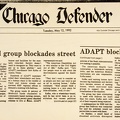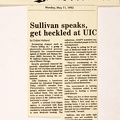Chicago Tribune Tuesday, May 12, 1992
Title: State thwarts protest, so disabled switch site
By Rob Karwath
A threatened demonstration by wheelchair-bound protesters prompted an unprecedented show of force Monday at the 16-floor glass-and-steel State of Illinois Center.
The demonstrators instead targeted federal offices several blocks south, leaving 3,000 state workers walking along barricaded corridors and past security checkpoints in the building at 100 W. Randolph St.
Workers had to tell uniformed police where they were going. Security guards manned the elevators. A trip from an upper floor to a main-floor coffee shop became a half-hour journey.
The preparations were made for a group that has become increasingly militant, with members at times chaining themselves to objects and forming chains of wheelchairs.
After experiencing a day of the clampdown, most employees interviewed said they thought the state Department of Central Management Services, which runs the building, has overreacted.
“It's ridiculous," said Peggy Craddieth, a secretary at the Illinois Pollution Control Board. “Even during Operation Desert Storm they weren’t this tight.”
State officials said the tight security will continue all week, or at
least until the protesters from Americans Disabled for Attendant Programs Today (ADAPT) leave town.
The heavy security seemed out of place to those familiar with the idea behind the wide—open state building. Architect Helmut Jahn created the building to symbolize the openness of a properly run democracy. Jahn’s concept was former Gov. James Thompson's frequent retort to anyone who criticized the building as a poor use of space.
“There’s a general discomfort all across the office about this,” said Rob Cushing, a lawyer in the lllinois attorney general‘s office. He said of the demonstrators, “We shouldn't have to go through all of this to deny them their right to protest.”
Central Management Services officials said they never intended to create a problem with the extra security, which included calling all department police in on their days off and hiring l6 private security guards at a cost of about $2,000 a day.
Instead, department spokeswoman Helen Adorjan said the state was simply trying to keep the building open after receiving a call from ADAPT warning that the group might try to block doors and elevators at the building this week.
The group is protesting what it believes to be a lack of government funds for programs that allow disabled people to live at home and avoid nursing homes. ADAPT did block doorways and elevators Monday in at least one Loop building where federal offices are housed.
Diane Coleman, an organizer in ADAPT, said Monday that the
group went to 105 W. Adams, the Bankers Building, because it houses one of the regional offices of the Department of Health and Human Services.
“There have been movements by `groups` like this before, but they were neglecting civil rights tactics—taking it to the streets,” she said. “And we'll do it until we win this issue. Six times the money goes to nursing homes and other institutions than to home and community-based services. We want 25 percent of that nursing home budget to go to home care."
Many State of Illinois building workers said they were concerned that everyone entering the building was barred from the Easement and first-floor elevators, which were roped of and guarded by Central Management Services police officers.
Yellow and black paper signs directed workers and patrons to an escalator that took them to the second floor where they were allowed to board the elevators. The escalator guaranteed that any wheechair-bound protesters wouldn‘t make it beyond the ground level.
But some state workers said they were concerned that wheelchair-bound employees and disabled people with state business had to specially request that an elevator descend to the first floor and then convince building police that they were not protesters.
“ls it fair for someone who shows up in a wheelchair to have
to declare their business?" asked Alex Des Chenes, a contractor with the state Department of Public Health.
“Have you seen the tapes of what the have done in other cities?” Anforjan said. “This group completely immobilizes activity. They need to be able to express themselves, but we need to keep the building operating."
But, in an effort to prevent a disruption, workers said all of the
extra security only ended up causing a disruption.
The building's Lake Street entrance was open, but a large steel gate inside the revolving glass doors sealed it off to all but riders of the CTA subway trains below.
A newsstand and a Chinese restaurant located inside the entrance were empty as most of their customers were forced to bypass them.
Even some of the Central Management Services police running the elevators said they disagreed with the security plan and would have tried less-disruptive measures.
“Everybody’s complaining about this," said one officer, shaking his head as he punched elevator buttons. “It‘s crazy."
Tribune photo by David Klobucar: A mass of people are clustered in one big not. ADAPT protesters in wheelchairs are on the street and people in suits and similar work outfits are making their way down the log jammed sidewalk, up to the police barricades. A woman in a dress is stepping over and through two of the protesters so she can continue in the street. Between the street and the sidewalk a metal police barricade is partially visible, and two uniformed officers appear to be casually trying to hold the barricades up.
Caption reads: Protesters from Americans Disabled for Attendant Programs Today block an entrance to the U.S. Health and Human Services Department on West Adams Street Monday.
- Author
- Chicago Tribune / Rob Karwath / photo by David Klobucar
- Created on
- Friday 12 July 2013
- Posted on
- Thursday 29 November 2018
- Tags
- ADAPT - American Disabled for Attendant Programs Today, blocking elevators, blocking entrances, blocking the building, chaining, checkpoints, Diane Coleman, escalator, HHS Regional offices, local people with disabilities, other people in wheelchairs, percent of money for nursing homes versus community attendant services, redirect 25%, security, State of Illinois Center, wheelchair bound, workers
- Albums
- Visits
- 1067
- Rating score
- no rate
- Rate this photo


0 comments